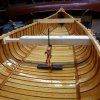martin ferwerda
W/C Canoes
Has anyone thought up any ingenious way to clinch those tacks in the middle of a canoe, when you are just one person, other than just doing the big arm stretch and hoping you hit the tack head you can barely see with the hammer ? Just looking for ideas.






